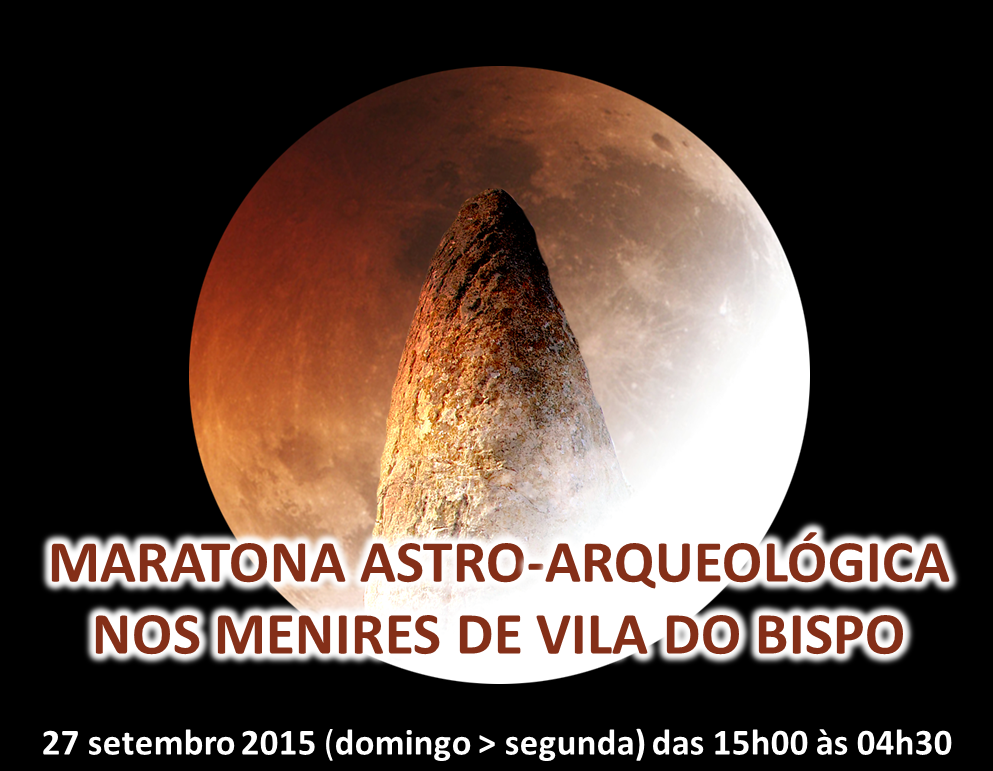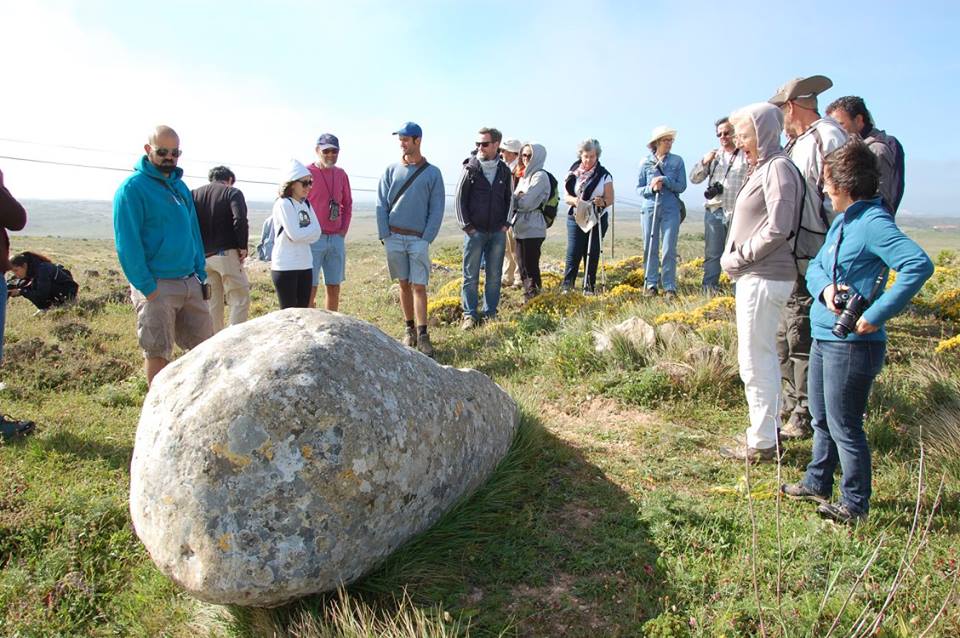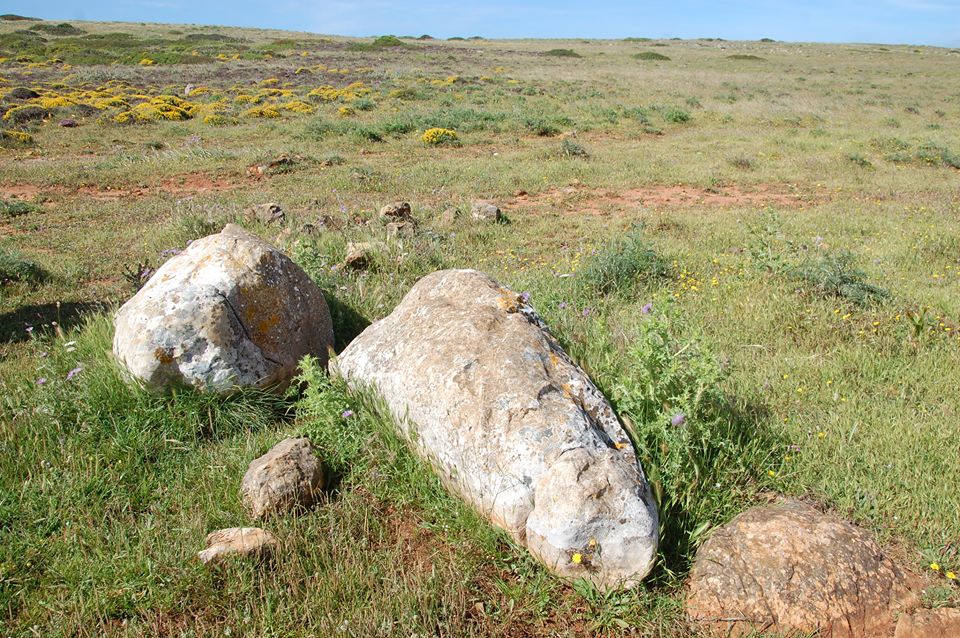 The rare sequence of astronomical events – Autumn Equinox, Autumn Full Moon, Super Moon, Equinoctial Sunset, Total Moon Eclipse – motivates, on September 27th, the first Astro-Archaeological Marathon in the Menhirs of Vila do Bishop.
The rare sequence of astronomical events – Autumn Equinox, Autumn Full Moon, Super Moon, Equinoctial Sunset, Total Moon Eclipse – motivates, on September 27th, the first Astro-Archaeological Marathon in the Menhirs of Vila do Bishop.
Between 19:27 pm on the 4th and 28:XNUMX am on the XNUMXth, there will be a vast program of activities, which will culturally integrate these rare astronomical events from an archaeological, historical and ethnographic perspective.
«In the civil calendar, the next day of September 27 coincides with a sequence of astronomical events which, throughout the History of Humanity, have determined a series of interesting cultural correspondences, among which we propose to integrate the megalithic phenomenon, in other words, some of our menhirs from Vila do Bispo», explains archaeologist Ricardo Soares, from Câmara of Vila do Bispo.
The program starts at 15 pm, at the Interpretation Center of Vila do Bispo, with the presentation of some results of the research project «Landscape Astronomy in the Meniric Megalithism of Vila do Bispo vs Bensafrim-Odiáxere interfluvial» and contextualization of the symbolism of Equinoctial and Full Moons , in particular, of the astronomical sequence.
At 18:00 pm, there is a trip to Hortas do Tabual, to observe the birth of the Full Moon in Autumn (19:11) and the sunset of the equinoctial Sun (19:23), «whose symbolism we admit to have been included in the selection of the places where some of the standing stones were erected”.

«At night, we will make a megalithic route between the menhirs of Pedra Escorregadia, Monte dos Amantes and Cerro do Camacho (Vila do Bispo) to observe the symbolic decorations inscribed in them, using directed lighting».
The night tour starts at 21:30 pm, culminating at 23:00 pm with astronomical observations with optical equipment – “a timeless mythological theater projected on the immense celestial stage”.
In the early morning hours of the 28th, the resisters are invited to watch the total eclipse of the Moon, which will take place between 2:07 am and 4:23 am…
This initiative is part of the European Heritage Days 2015 and results from the research projects “Archaeological Map of the Municipality of Vila do Bispo” (Ricardo Soares, CMVB, 2014-2015) and “Landscape Astronomy in the Meníric Megalithism of Vila do Bispo vs interfluvial Bensafrim-Odiáxere”, the latter from the initiative of electrical engineer Fernando Pimenta, member of the European Society for Astronomy in Culture, and Ricardo Soares, archaeologist at the Vila do Bispo Council.
Archaeological and Archeological Chart Astronomy Landscape

Os standing stones in the municipality of Vila do Bispo and the Bensafrim-Odiáxere interfluvial area are located in a region where the occupation attributable to the ancient Neolithic shows some characteristics that differentiate it from other contexts of standing stones, namely those present in neighboring Central Alentejo.
If, on the one hand, the menhirs of Vila do Bispo contradict the logics estimated for other regional blocks, such as the «particularity of being associated with the establishment of prehistoric settlements», on the other hand, there are still no known funerary rituals that could be related, 'possibly latent in cave contexts'.
Although very fragmented and out of context, in the municipality of Vila do Bispo, in an area of just over 42 square kilometers, around 250 standing stones were referenced – which is pointed out by those responsible for the investigation as «the apex of an immense and in lost part “iceberg” of stone!»
«This is a resistant and significant sample, with great material, morphological and decorative consistency. However, the fact that most of these menhirs are torn down, fragmented and displaced from their original location greatly affects their study», they explain.
Within the scope of the research project – Landscape ArchaeoAstronomy in the Menhiric Megalithism of Vila do Bispo vs Bensafrim-Odiáxere interfluvial – a methodology of statistical and geographic analysis of the implantation, distribution and global orientation in the landscape of the current location of the menhirs was applied.
This preliminary study was carried out with the aim of evaluating the extent to which this approach could reveal patterns between the megalithic areas of Vila do Bispo and the Bensafrim-Odiáxere interfluvial area, justifying the eventual continuation of the investigation with a more ambitious program.
The preliminary results of the applied methodology will be presented at the Interpretation Center of Vila do Bispo, at 15:27 on the next XNUMXth of September.
They will be divided into three themes and discussed in light of some possible interpretations: Spatial pattern of occupation of the territory; Local topographic analysis: elevation, slope and maximum slope azimuth; Topographic analysis of the horizon: direction to the highest distant peak, distance to the horizon profile as a function of azimuth and marks on the horizon as a function of declination.
Despite the limitations with which this study was carried out, namely the use of a digital terrain model with a grid of 90 x 90 meters, with known inaccuracies, not fully confirmed locations and incomplete classification of the engravings, the results showed «surprising patterns, motivating us to make efforts to expand the study area, improve the analysis tools, complement the database by updating the respective locations and characteristics, pursue clues for the identification of villages and explore cave contexts in search of evidence of practices funeral homes of those populations».
«Some recent discoveries, resulting from archaeological surveys carried out between 2014-2015 within the scope of the project Archaeological Map of the Municipality of Vila do Bispo, after being deepened, may significantly contribute to the construction of a more complete and coherent narrative about the Neolithic Revolution and the megalithic phenomenon in the Barlavento Algarvio region – a monumental cultural heritage», stresses archaeologist Ricardo Soares.
Information and contacts: Vila do Bispo Interpretation Center | Ricardo Soares – 966 616 527, [email protected]


















Comments